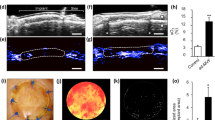Abstract
A bilayered artificial dermis (AD) composed of an upper silicone sheet and a lower collagen sponge has been widely applied for skin defects. After application, fibroblasts and capillaries infiltrate the AD and the collagen sponge is replaced by host dermal tissue within a few weeks. However, this delay and the high incidence of infection are concerns regarding the use of AD in the treatment of chronic ulcers. In this study, we compared the neovascularization of conventional AD seeded with autologous fibroblasts (cultured dermis: CD) and collagen/gelatin sponge (CGS), which is a novel artificial dermis capable of sustained release of basic fibroblast growth factor (bFGF) after application using laser Doppler imaging (LDI). CD (n = 5) and CGS impregnated with bFGF (n = 6) were applied to diabetic foot ulcers after debridement. Perfusion units (PUs) were measured just after, and 1, 2 and 3 weeks after application, and complete healing rates within 16 weeks were compared. No significant differences in PUs were seen 1, 2 and 3 weeks after application and in healing rates within 16 weeks between the two groups. This study suggested that CD and CGS treatments were effective, but there were no significant differences between them in the treatment of diabetic ulcers .



Similar content being viewed by others
References
Yannas IV. Emerging rules for inducing organ regeneration. Biomaterials. 2013;34:321–30.
Suzuki S, Matsuda K, Nishimura Y, et al. Review of acellular and cellular artificial skins. Tissue Eng. 1996;2:267–75.
Momoh AO, Lypka MA, Echo A, et al. Reconstruction of full-thickness calvarial defect: a role for artificial dermis. Ann Plast Surg. 2009;62:656–9.
Ito K, Ito S, Sekine M, et al. Reconstruction of the soft tissue of a deep diabetic foot wound with artificial dermis and recombinant basic fibroblast growth factor. Plast Reconstr Surg. 2005;115:567–72.
Ehrenreich M, Ruszczak Z. Update on tissue-engineered biological dressings. Tissue Eng. 2006;12:2407–24 (Review).
Langer A, Rogowski W. Systematic review of economic evaluations of human cell-derived wound care products for the treatment of venous leg and diabetic foot ulcers. BMC Health Serv Res. 2009;9:115.
Uchi H, Igarashi A, Urabe K, Koga T, Nalayama J, Kawamori R, Tamaki K, Hirakata H, Ohura T, Furue M. Clinical efficacy of basic fibroblast growth factor (bFGF) for diabetic ulcer. Eur J Dermatol. 2009;19:461–8.
Morimoto N, Takemoto S, Kanda N, Ayvazyan A, Taira MT, Suzuki S. The utilization of animal product-free media and autologous serum in an autologous dermal substitute culture. J Surg Res. 2011;171:339–46.
Morimoto N, Ito T, Takemoto S, Katakami M, Kanda N, Tada H, Tanaka S, Teramukai S, Kawai K, Nakamura Y, Kasai Y, Masayuki Y, Maekawa T, Shimizu A, Suzuki S. An exploratory clinical study on the safety and efficacy of an autologous fibroblast-seeded artificial skin cultured with animal product-free medium in patients with diabetic foot ulcers. Int Wound J. 2014;11:183–9.
Takemoto S, Morimoto N, Kimura Y, Taira T, Kitagawa T, Tomihata K, Tabata Y, Suzuki S. Preparation of collagen/gelatin sponge scaffold for sustained release of bFGF. Tissue Eng Part A. 2008;14:1629–38.
Kanda N, Morimoto N, Ayvazyan AA, Takemoto S, Kawai K, Nakamura Y, Sakamoto Y, Taira T, Suzuki S. Evaluation of a novel collagen-gelatin scaffold for achieving the sustained release of basic fibroblast growth factor in a diabetic mouse model. J Tissue Eng Regen Med. 2014;8:29–40.
Morimoto N, Yoshimura K, Niimi M, Ito T, Aya R, Fujitaka J, Tada H, Teramukai S, Murayama T, Toyooka C, Miura K, Takemoto S, Kanda N, Kawai K, Yokode M, Shimizu A, Suzuki S. Novel collagen/gelatin scaffold with sustained release of basic fibroblast growth factor: clinical trial for chronic skin ulcers. Tissue Eng Part A. 2013;19:1931–40.
Morimoto N, Takemoto S, Kawai K, Aya R, Ishisaka T, Suzuki S. Immediate evaluation of neovascularization in a grafted bilayered artificial dermis using laser Doppler imaging. Ann Plast Surg. 2014;72:84–8.
Monstrey SM, Hoeksema H, Baker RD, et al. Burn wound healing time assessed by laser Doppler imaging. Part 2: validation of a dedicated colour code for image interpretation. Burns. 2011;37:249–56.
Riordan CL, McDonough M, Davidson JM, et al. Noncontact laser Doppler imaging in burn depth analysis of the extremities. J Burn Care Rehabil. 2003;24:177–86.
Vuorisalo S, Venermo M, Lepäntalo M. Treatment of diabetic foot ulcers. J Cardiovasc Surg. 2009;50:275–91 (Review).
Singh N, Armstrong DG, Lipsky BA. Preventing foot ulcers in patients with diabetes. JAMA. 2005;293:217–28.
Marston WA, Hanft J, Norwood P, Pollak R. The efficacy and safety of Dermagraft in improving the healing of chronic diabetic foot ulcers: results of a prospective randomized trial. Diabetes Care. 2003;26:1701–5.
Cavorsi J, Vicari F, Wirthlin DJ, Ennis W, Kirsner R, O’Connell SM, Steinberg J, Falanga V. Best-practice algorithms for the use of a bilayered living cell therapy (Apligraf) in the treatment of lower-extremity ulcers. Wound Repair Regen. 2006;14:102–9 (Review).
Tuyet HL, Quynh TTN, Minh HVH, Bich DNT, Dinh TD, Tan DL, Van HL, Huy TL, Huu HD, Trong TNT. The efficacy and safety of epidermal growth factor in treatment of diabetic foot ulcers: the preliminary results. Int Wound J. 2009;6:159–66.
Senet P, Vicaut E, Beneton N, Debure C, Lok C, Chosidow O. Topical treatment of hypertensive leg ulcers with platelet-derived growth factor-BB: a randomized controlled trial. Arch Dermatol. 2011;147:926–30.
Yamada N, Uchinuma E, Kuroyanagi Y. Clinical trial of allogeneic cultured dermal substitutes for intractable skin ulcers of the lower leg. J Artif Organs. 2008;11:100–3.
Dinh TL, Veves A. The efficacy of Apligraf in the treatment of diabetic foot ulcers. Plast Reconstr Surg. 2006;117:152S–7S (Review).
Conflict of interest
The authors declare that they have no conflict of interest.
Author information
Authors and Affiliations
Corresponding authors
Rights and permissions
About this article
Cite this article
Morimoto, N., Kakudo, N., Valentin Notodihardjo, P. et al. Comparison of neovascularization in dermal substitutes seeded with autologous fibroblasts or impregnated with bFGF applied to diabetic foot ulcers using laser Doppler imaging. J Artif Organs 17, 352–357 (2014). https://doi.org/10.1007/s10047-014-0782-0
Received:
Accepted:
Published:
Issue Date:
DOI: https://doi.org/10.1007/s10047-014-0782-0




